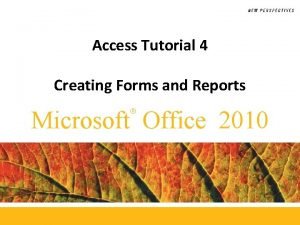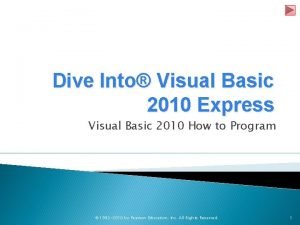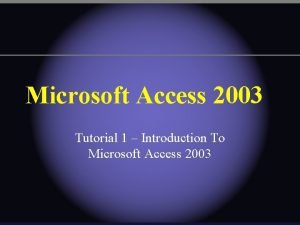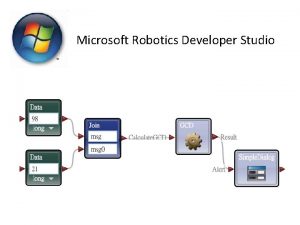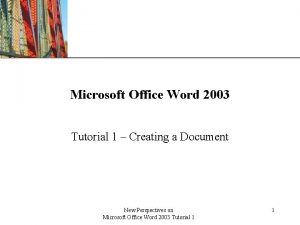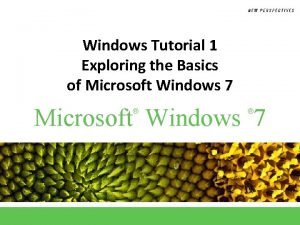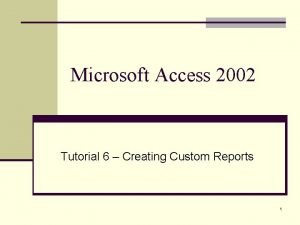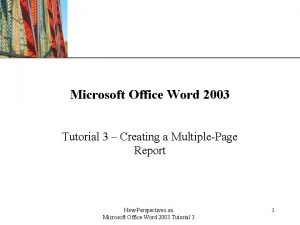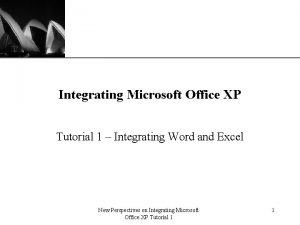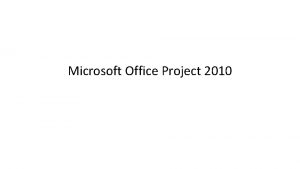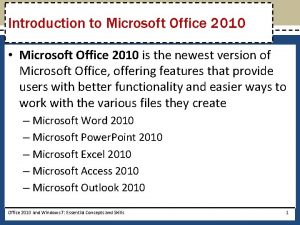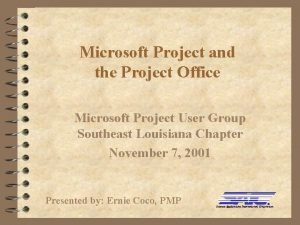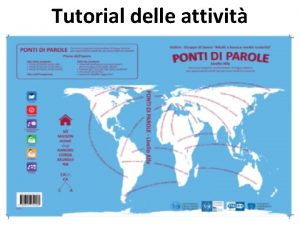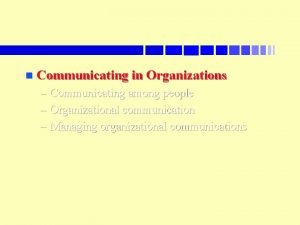Tutorial 3 Communicating Project Information Microsoft Project 2010



















































- Slides: 51

Tutorial 3: Communicating Project Information Microsoft Project 2010 ®

In this tutorial you will: • • XP Review Project 2010 reports Examine the critical path Filter tasks Format a Gantt Chart Work with the Network Diagram Shorten the critical path Analyze task constraints New Perspectives on Microsoft Project 2010 2

Creating Reports Using Project 2010 XP • In addition to printing graphical views, Project 2010 can be used to create other reports. • Reports can be used to: – disseminate information – report project status – plan a project • Viewing different reports will help you to analyze your current project plan in different ways. New Perspectives on Microsoft Project 2010 3

Project 2010 Reports New Perspectives on Microsoft Project 2010 XP 4

Understanding the Critical Path XP • A critical task is a task that must be completed as scheduled in order for the project to finish on time. – Any delay in a critical task could delay the project completion date. • The critical path is the series of critical tasks (or even a single critical task) that indicates the calculated Finish date of the project. – The critical path determines the earliest the project can be completed. New Perspectives on Microsoft Project 2010 5

Understanding the Critical Path Cont. XP • The critical path changes if tasks on the critical path are completed ahead of or behind schedule. • Another way to define the critical path is that it consists of those tasks having a float of zero. – Float, also called total slack, is the amount of time that a task can be delayed from its planned start date without delaying the project Finish date. – Total slack differs from free slack. Free slack is the amount of time that a task can be delayed without delaying any successor tasks. New Perspectives on Microsoft Project 2010 6

Understanding the Critical Path Cont’d XP • If any tasks on the critical path take longer then planned, the project completion date will slip unless corrective action is taken. • Viewing the Network Diagram makes it easy to see the critical path because critical tasks are automatically displayed in red. New Perspectives on Microsoft Project 2010 7

Critical Path New Perspectives on Microsoft Project 2010 XP 8

The Importance of Communicating Information about the Critical Path XP • It is very important for a project manager to have excellent skills in finding, analyzing, and communicating information about the critical path throughout the life of the project. • Filters, formats, and customizing the Network Diagram help the manager accomplish this. New Perspectives on Microsoft Project 2010 9

Filtering Tasks for Information XP • A filter temporarily hides some of the tasks so that only those tasks that you are interested in are displayed. • Filters help you to focus your attention on specific aspects of the project based on different criteria. • Project 2010 offers many built-in filters, available using the Filter list arrow on the Formatting toolbar. • One of the most important filters used is “Critical” because it filters out all tasks not currently on the critical path. New Perspectives on Microsoft Project 2010 10

Filter List Options New Perspectives on Microsoft Project 2010 XP 11

Filtering Tasks for Information Cont. XP • Filters can be applied in any view, but each view is filtered independently of the others. • Other filters such as Milestones, Task Range, and Date Range can be used at any time. • Filters temporarily hide those tasks that do not meet the filter criteria. • It is also important to note that filters are only “correct” as of the moment they are applied. • If you make a change to a filtered project, you must reapply the filter. New Perspectives on Microsoft Project 2010 12

Filtered for “Critical” New Perspectives on Microsoft Project 2010 XP 13

Filtered for a date range New Perspectives on Microsoft Project 2010 XP 14

Using the Auto. Filter XP • The Auto. Filter allows you to determine the filter criteria by selecting from a criteria list associated specifically with each column in the Entry table. – When you select Auto. Filter on the Formatting Toolbar, a list arrow is displayed to the right of each field name in the Entry table. – You choose filter criteria for a column by clicking the list arrow in the column heading. • You can apply custom filters using the Auto. Filter list arrows. New Perspectives on Microsoft Project 2010 15

Auto. Filter for Starts in Sept. New Perspectives on Microsoft Project 2010 XP 16

Custom Filters XP • Useful to filter using two criteria • Useful to filter using comparison operators. – <=, >= can be combined with AND or OR • The Custom Auto. Filter box is used to create custom filters. New Perspectives on Microsoft Project 2010 17

Custom Auto. Filter Dialog Box New Perspectives on Microsoft Project 2010 XP 18

Printing Filtered View XP • You can print any filtered view of a project. • Entering information such as your name, the date, perhaps a time, and filename into the header and footer sections help identify the project file on the printout. • This can be helpful when presenting a filtered list of tasks. New Perspectives on Microsoft Project 2010 19

Formatting a Project XP • Sometimes you want to highlight information in a project by changing the appearance of the default views. For example: – Change the color of certain types of task bars. – Change the text font size within a table. • Project 2010 provides many ways to format the colors, shapes, and text within each project view to help you clearly communicate your message. New Perspectives on Microsoft Project 2010 20

Formatting a Gantt Chart XP • Project 2010 applies default formatting choices such as blue for task bars and black for summary bars. • You can change the default options individually or by using Gantt Chart Styles. • Enhancing the appearance of certain task bars of a Gantt Chart customizes the project and helps you communicate the information to management. New Perspectives on Microsoft Project 2010 21

Changing Bar Style with the Gantt. XP Chart Style Gallery New Perspectives on Microsoft Project 2010 22

Formatted Gantt Chart New Perspectives on Microsoft Project 2010 XP 23

Formatting a Gantt Chart Cont. XP • Project 2010 has many formatting options for the Gantt Chart. • The key to formatting the Gantt Chart is that the final product should clearly and quickly communicate the information that is important to the project manager and management. • As the project progresses, you can always reformat the Gantt Chart to highlight any new important messages. New Perspectives on Microsoft Project 2010 24

Formatting an Entry Table XP • You can click any cell within the Entry table and choose a new font, font size, font effect, or color. • By visually organizing the tasks, you help communicate what needs to be done in the project. • Formatting tasks by category changes all formatting for the specified category. • Formatting options are available to help you communicate project information to management as you work with Project 2010. New Perspectives on Microsoft Project 2010 25

Text Styles Dialog Box New Perspectives on Microsoft Project 2010 XP 26

Formatting Individual Items in the Entry Table and Gantt Chart XP • Many options on the Formatting toolbar and Format menu are used formatting individual tasks. For example: – Format the tasks that you have assigned to an outside contractor with an italic font. – Temporarily change the color of one Gantt Chart bar to highlight it for a meeting. New Perspectives on Microsoft Project 2010 27

Individual Formatting Changes Applied New Perspectives on Microsoft Project 2010 XP 28

Formatting the Timescale XP • The timescale can display three tiers simultaneously. • You may be working on a project that requires that level of detail on the timescale. • You can set the timescale to show all three tiers and format each one. New Perspectives on Microsoft Project 2010 29

Timescale with Formatting New Perspectives on Microsoft Project 2010 XP 30

Formatting Gridlines & Link Lines XP • Gridlines are nonprinting lines that improve readability. • Gridlines help you locate current dates or intervals. • Link lines show connections between bars and are used to add visual impact. New Perspectives on Microsoft Project 2010 31

Working with the Network Diagram View XP • Network Diagram most clearly identifies the dependencies (also called relationships) between the tasks, as well as the critical path. • You need to be able to complete basic actions such as entering and editing tasks in any view that you use. New Perspectives on Microsoft Project 2010 32

Examining Dependencies and the Critical Path XP • The primary purpose of the Network Diagram is to clearly illustrate the sequential progression of tasks and the critical path. • Project managers often use the Network Diagram view to enter and edit task dependencies. New Perspectives on Microsoft Project 2010 33

Manually Moving Tasks for Printouts XP • Network Diagram printouts can be quite wide, so you might want to move tasks in order to better arrange them for printouts. • If you plan to show them to your colleagues or to management, you must be organized so as to best communicate the information. New Perspectives on Microsoft Project 2010 34

Revised Network Diagram New Perspectives on Microsoft Project 2010 XP 35

Filtering and Formatting in Network Diagram View XP • Filtering – Almost the same as in Gantt view – Auto. Filter is not available • Formatting – Almost the same as in Gantt View – Changes are made by modifying settings in the Box Styles dialog box. New Perspectives on Microsoft Project 2010 36

Box Styles Dialog Box New Perspectives on Microsoft Project 2010 XP 37

Shortening the Critical Path by Using XP Task Information • There are several ways to shorten the Critical Path: – – – – Change the task duration Change the task dependencies Add more resources (Crashing) Run tasks in parallel (Fast-tracking) Add negative lag-time Modify the work calendar Remove task constraints New Perspectives on Microsoft Project 2010 38

Shortening the Critical Path by Using XP Task Information Cont. • • • Any direct change to a task must be a true reflection of reality. Shortening the path purely for the sake of shortening the project on paper only confuses participants and brings them stress. Find ways to shorten the critical path by using techniques that can realistically be accomplished once the project is started. New Perspectives on Microsoft Project 2010 39

The Project 2010 Task Inspector XP • Identifies factors that affect the start date of tasks • Displays error messages for the tasks • Provides suggestions for changing start dates and dependencies • Can identify if a task begins before its predecessor ends • Offers selectable suggestions to ‘fix’ tasks. New Perspectives on Microsoft Project 2010 40

Task Inspector Task Pane New Perspectives on Microsoft Project 2010 XP 41

Shorten the Critical Path by Changing Task Dependencies XP • Sometimes a Finish-to-Start (FS) dependency is created when it is not necessary. • A dependency that requires less total time, such as a Start-to-Start (SS) or Finish-to-Finish (FF) might be more appropriate. • To change a task dependency, double-click on the link between tasks to open the Task Dependency dialog box, then alter the dependency type. New Perspectives on Microsoft Project 2010 42

Shortening the Schedule by deleting FS Dependencies New Perspectives on Microsoft Project 2010 XP 43

Fast Tracking XP • Fast tracking is when you perform activities in parallel that you would normally do in sequence. For example: – You might have planned to finish all of the analysis work before starting design, but you decide to start the design when the analysis is 75 percent complete. New Perspectives on Microsoft Project 2010 44

Negative Lag Time XP • Another technique to shorten the critical path is to add negative lag time to an existing Finish-to-Start (FS) dependency between two critical tasks. – Negative lag time always allows the tasks to overlap, regardless of whether the project is scheduled from a given Start or Finish date. – When a project is scheduled from a given Start date, negative lag time pulls the second task in the dependency backward in time. New Perspectives on Microsoft Project 2010 45

Changing Calendar and Task Constraints XP • If you know of a task whose working time does not follow that of the Standard calendar, you should create a special calendar with the appropriate working and nonworking times and assign it to that task. • Another way to shorten the critical path is to analyze and eliminate unnecessary date constraints that have been applied to the tasks within your project. • A constraint is a restriction that you put on a task’s Start or Finish date. New Perspectives on Microsoft Project 2010 46

Changing Calendar and Task Constraints Cont’d XP • Be very careful about entering date constraints because they will definitely remove some flexibility in recalculating individual task Start and Finish dates. • Project 2010 places an icon in the Indicator column for any constraint other than As Soon As Possible and As Late As Possible to alert you. New Perspectives on Microsoft Project 2010 47

Constraint Types New Perspectives on Microsoft Project 2010 XP 48

Constraint Applied New Perspectives on Microsoft Project 2010 XP 49

Viewing the Entire Project Using the Timeline to show Summary Tasks New Perspectives on Microsoft Project 2010 XP 50

Comparison of Gantt Chart View and Network Diagram View New Perspectives on Microsoft Project 2010 XP 51
 Microsoft project schedule tutorial
Microsoft project schedule tutorial Ms project 2010 tutorial
Ms project 2010 tutorial Microsoft project tutorial
Microsoft project tutorial Processus vaginalis
Processus vaginalis Outlook 2010 training
Outlook 2010 training Ms project 2007 tutorial
Ms project 2007 tutorial Ms project 2007 tutorial
Ms project 2007 tutorial Visual basic 2010 express tutorial
Visual basic 2010 express tutorial Microsoft access forms tutorial
Microsoft access forms tutorial Visio 2010 updates
Visio 2010 updates Microsoft excel merupakan aplikasi pengolah
Microsoft excel merupakan aplikasi pengolah Microsoft excel 2010 training
Microsoft excel 2010 training Email archiving and retention exchange 2012
Email archiving and retention exchange 2012 Visual basic 10 express
Visual basic 10 express Microsoft forefront protection 2010 for exchange server
Microsoft forefront protection 2010 for exchange server Ikon pada toolbar untuk format penomoran adalah
Ikon pada toolbar untuk format penomoran adalah Microsoft lync attendee
Microsoft lync attendee Microsoft power point 2010
Microsoft power point 2010 Microsoft lync 2010 attendee
Microsoft lync 2010 attendee Ms project agile
Ms project agile Microsoft access tutorial 2013
Microsoft access tutorial 2013 Microsoft identity manager roadmap
Microsoft identity manager roadmap Ms access 2003 tutorial
Ms access 2003 tutorial Omada identity
Omada identity Microsoft robotics developer studio
Microsoft robotics developer studio Microsoft test manager tutorial
Microsoft test manager tutorial Microsoft word 2003 tutorial
Microsoft word 2003 tutorial Microsoft windows tutorial
Microsoft windows tutorial Microsoft robotics developer studio tutorial
Microsoft robotics developer studio tutorial Ms access reports tutorial
Ms access reports tutorial Word 2003 tutorial
Word 2003 tutorial Microsoft office xp tutorials
Microsoft office xp tutorials Microsoft official academic course microsoft word 2016
Microsoft official academic course microsoft word 2016 Microsoft official academic course microsoft excel 2016
Microsoft official academic course microsoft excel 2016 Value octagon
Value octagon Microsoft excel merupakan program program aplikasi
Microsoft excel merupakan program program aplikasi Microsoft official academic course microsoft word 2016
Microsoft official academic course microsoft word 2016 Means communication without words. *
Means communication without words. * Aperiodic markov chain
Aperiodic markov chain Normal pressure hydrocephalus treatment
Normal pressure hydrocephalus treatment Memutuskan bauran komunikasi pemasaran
Memutuskan bauran komunikasi pemasaran Communicating hydrocephalus
Communicating hydrocephalus Communicating in the digital age workplace
Communicating in the digital age workplace Communicating for results a canadian student’s guide
Communicating for results a canadian student’s guide Healthy relationships communicating effectively
Healthy relationships communicating effectively Communicating in teams and organizations
Communicating in teams and organizations Communicating across cultures ppt
Communicating across cultures ppt The language of business is known as
The language of business is known as Communicating customer value
Communicating customer value Communication of research findings
Communication of research findings Predicting science process skills
Predicting science process skills Science process skills communicating
Science process skills communicating








